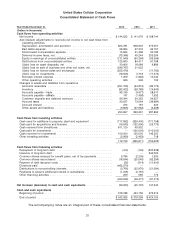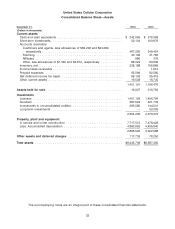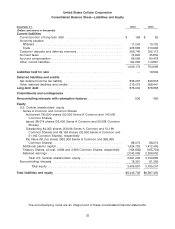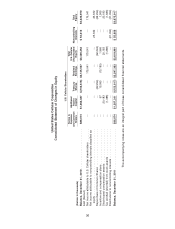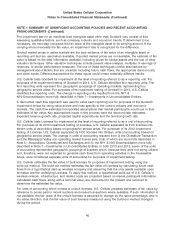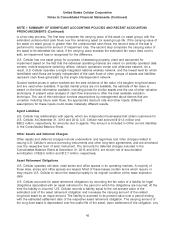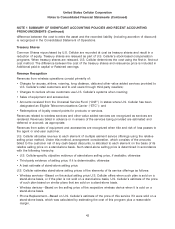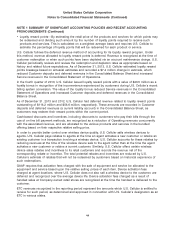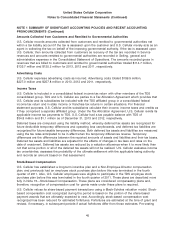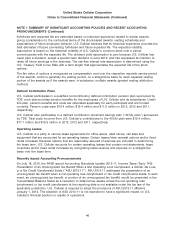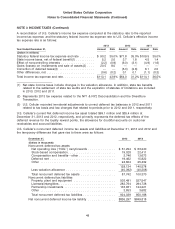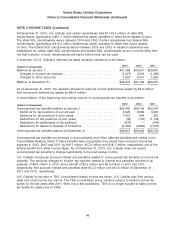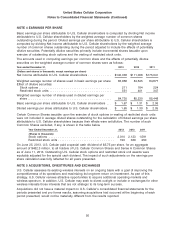US Cellular 2013 Annual Report Download - page 48
Download and view the complete annual report
Please find page 48 of the 2013 US Cellular annual report below. You can navigate through the pages in the report by either clicking on the pages listed below, or by using the keyword search tool below to find specific information within the annual report.United States Cellular Corporation
Notes to Consolidated Financial Statements (Continued)
NOTE 1 SUMMARY OF SIGNIFICANT ACCOUNTING POLICIES AND RECENT ACCOUNTING
PRONOUNCEMENTS (Continued)
The impairment test for an indefinite-lived intangible asset other than Goodwill may consist of first
assessing qualitative factors, such as company, industry and economic trends. If determined to be
necessary, the next step compares the fair value of the intangible asset to its carrying amount. If the
carrying amount exceeds the fair value, an impairment loss is recognized for the difference.
Quoted market prices in active markets are the best evidence of fair value of an intangible asset or
reporting unit and are used when available. If quoted market prices are not available, the estimate of fair
value is based on the best information available, including prices for similar assets and the use of other
valuation techniques. Other valuation techniques include present value analysis, multiples of earnings or
revenues, or similar performance measures. The use of these techniques involve assumptions by
management about factors that are uncertain including future cash flows, the appropriate discount rate,
and other inputs. Different assumptions for these inputs could create materially different results.
U.S. Cellular tests Goodwill for impairment at the level of reporting referred to as a reporting unit. For
purposes of its impairment testing of Goodwill in 2013, U.S. Cellular identified four reporting units. The
four reporting units represent four geographic groupings of operating markets, representing four
geographic service areas. For purposes of its impairment testing of Goodwill in 2012, U.S. Cellular
identified five reporting units. The change in reporting units resulted from the NY1 &
NY2 Deconsolidation more fully described in Note 7—Investments in Unconsolidated Entities.
A discounted cash flow approach was used to value each reporting unit for purposes of the Goodwill
impairment review by using value drivers and risks specific to the current industry and economic
markets. The cash flow estimates incorporated assumptions that market participants would use in their
estimates of fair value. Key assumptions made in this process were the discount rate, estimated
expected revenue growth rate, projected capital expenditures and the terminal growth rate.
U.S. Cellular tests Licenses for impairment at the level of reporting referred to as a unit of accounting.
For purposes of its 2013 impairment testing of Licenses, U.S. Cellular separated its FCC licenses into
eleven units of accounting based on geographic service areas. For purposes of its 2012 impairment
testing of Licenses, U.S. Cellular separated its FCC licenses into thirteen units of accounting based on
geographic service areas. The change in units of accounting resulted from (i) the Divestiture Transaction
and the Mississippi Valley non-operating market license sale, both of which are more fully described in
Note 5—Acquisitions, Divestitures and Exchanges and (ii) the NY1 & NY2 Deconsolidation more fully
described in Note 7—Investments in Unconsolidated Entities. In both 2013 and 2012, seven of the units
of accounting represented geographic groupings of licenses which, because they were not being utilized
and, therefore, were not expected to generate cash flows from operating activities in the foreseeable
future, were considered separate units of accounting for purposes of impairment testing.
U.S. Cellular estimates the fair value of built licenses for purposes of impairment testing using the
build-out method. The build-out method estimates the fair value of Licenses by calculating future cash
flows from a hypothetical start-up wireless company and assuming that the only assets available upon
formation are the underlying Licenses. To apply this method, a hypothetical build-out of U.S. Cellular’s
wireless network, infrastructure, and related costs are projected based on market participant information.
Calculated cash flows, along with a terminal value, are discounted to the present and summed to
determine the estimated fair value.
For units of accounting which consist of unbuilt licenses, U.S. Cellular prepares estimates of fair value by
reference to prices paid in recent auctions and market transactions where available. If such information is
not available, the fair value of the unbuilt licenses is assumed to change by the same percentage, and in
the same direction, that the fair value of built licenses measured using the build-out method changed
during the period.
40



